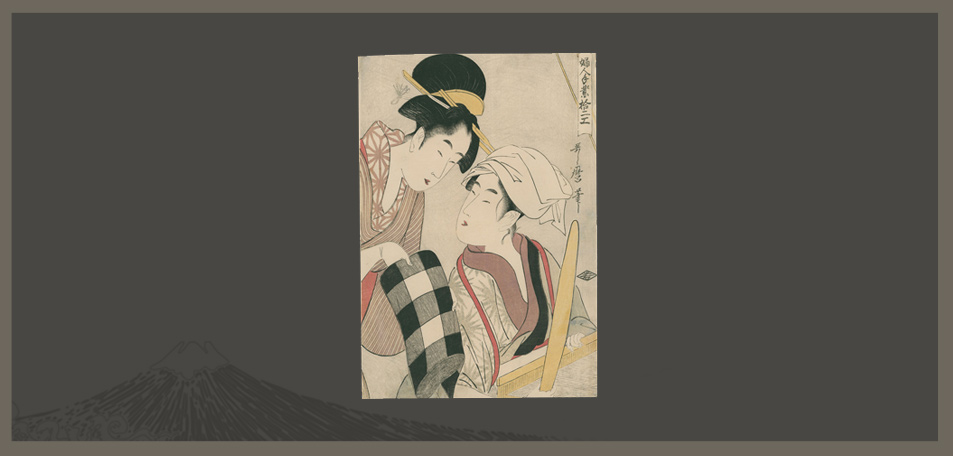What is the Floating World?
8/14/2015

It’s easy to find definitions for the term ukiyo-e, they exist throughout the internet and appear in nearly every treatise on the genre. The translation of ukiyo-e boils down to “pictures of the floating world,” created either in paintings or in woodblock prints.
What is the Floating World? According to David Waterhouse, Ukiyo could mean either “floating world” or “sad troublesome world,” and, of course, –e refers to the picture. The author notes that in the early seventeenth century, more cheerful interpretations of the term “ukiyo” made their way into printed collections of lighthearted tales, miscellanies and guidebooks. These very early printed texts were often illustrated with black-and-white woodcuts. The most influential such publication was Tale of the Floating World (Ukiyo Monogatari). Its introductory section recommends [ukiyo] for what one might call “going with the flow.” In practice, this implied disporting oneself in the pleasure quarters and theatre districts of Edo, Kyoto and Osaka, thus the term refers to what one might see when “going with the flow in the floating world.” These views of the floating world as depicted in woodblock prints and paintings are ukiyo-e. David Waterhouse, Hishikawa Moronobu, Tracking Down an Elusive Master, Essay for the 2008 Asia Society exhibition catalog, Designed for Pleasure.
Ukiyo-e pictures of the floating world included as their subjects: beautiful women, both courtesans and geisha; kabuki actors and sumo wrestlers; history and legend; travel scenes and landscapes; flora and fauna; and, an incredible volume of Shunga, literally “spring picture” (Erotica).
Ukiyo-e did not originally burst forth as full color pictures. The earliest prints, from the beginning of the 1600’s were impressions only in black ink. Occasionally colors might be added by hand using ground mineral pigments and expensive dyes that were painted in.
Richard Illing, author of The Art of Japanese Prints, describes a slow progress in the development of full color prints:
“Political factors did more to hold back these beautiful and ostentatiously colorful prints than to promote them. The robust and efficient Shogun Yoshimune, who came to power in 1716, found the nations economy in a parlous state and swiftly issued a series of sumptuary laws, generally designed to reduce the overall standard of living and especially to limit conspicuous luxury. Amongst the many detailed regulations were restrictions on increasing the complexity, color and expense of the prints, and these (rules) may have done much to prevent the earlier progression to color printing. Yoshimune retired at about the time that two color printing “benizuri-e” began to appear”. He was succeeded by weak and incompetent Shoguns…who allowed regulators to turn a blind eye to flagrant breaches of the laws. As the political climate eased, technical innovation in printing advanced. The “kento” mechanism to adjust registration of the colors of the benizuri-e was well known, but was further perfected using a new device, the Kuiki, which allowed for extra fine adjustment to the registration.
Changes were made in the wood selected for the printing blocks. Previously, fast growing catalpa wood and, less commonly, hinoki (cypress) had been used for engraving. Harder cherry wood blocks were introduced which allowed for finer printing and larger runs of prints. The masame-gami paper used hitherto was replaced by hosho, a luxurious, thick, soft absorbent paper that took up the pigments well, withstood the repeated rubbing of the baren and allowed the deep impressions of the blind-printing blocks.
All these changes and the wider range of special dyes and pigments used were expensive. The initial impetus that led to the introduction of these new techniques was the private commissions of wealthy connoisseurs. Once the breakthrough was achieved, however, no one wanted to revert to second-best and the full-color print became the norm. Richard Illing, The Art of Japanese Prints, 1980, at 41 – 42.
Production of ukiyo-e prints persisted during a prosperous and relatively peaceful period in Japan lasting more than 250 years, from Edo period (1603) through Meiji period (1912). The result of such longevity was a spectacular array of subgenre, including Yokohama, Osaka, and Nagasaki prints; Surimono and Egoyomi, stencil prints, illustrated books, news, handbills and broadsides and so on. Advancements in dye chemistry and printing techniques changed the look and feel of the prints over the ages, while the actual imagery of the prints documented and disseminated information about changing fashions, social movements, politics, maps, games, news and advertising. Various authors pronounced the medium/genre dead by the first decade of the twentieth century, but the medium and production methods just shape-shifted in concert with western influences of modernism and abstraction.
Because the prints were often published in large editions, scholars, collectors and dealers will see many of the same images over and over again and in various states ranging from never before seen brilliance and quality to dusty and tattered, moldy and decayed. While some designs are relatively common, many are so rare that we would be lucky to see even one example in a lifetime. The unending variety of images provides a collector with a rich and diverse environment in which to create a specialized collection.
